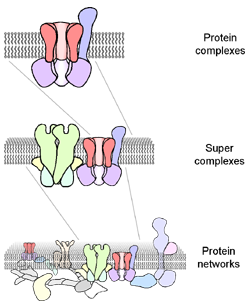Research
Our central goal is comprehensive understanding of organization and operation of rapid signal transduction and information processing at the plasma membrane of excitable cells under normal and pathophysiological conditions.
P
- how these proteins work
- how they are organized at the plasma membrane
- how they realize the enormous specificity of their signaling in both time and space and
- how their signaling is endowed with activity-dependent "dynamics" required for adaptation and formation of memory.
As a fundamental step in pursuing these questions, latest molecular research using the approach of "functional proteomics" demonstrated that ion channels and GPCRs are not operating as stand-alone tools, rather their signaling results from multiple protein-protein interactions that occur in the "molecular environments" of channel and receptor proteins.
Conceptually, the arrangements of protein complexes, signaling super-complexes or protein networks represent the platforms for organization and operation of rapid signal transduction through channels and/or receptors: They modulate channel/receptor properties and processing, affect downstream pathways or shape spatio-temporal concentration gradients of ions and other diffusible messengers.
Model Systems for Membrane Signaling
Although these insights have been promoted by analyses of quite a series of membrane proteins, we selected a few key players of neuronal signal transduction in synapses of CNS neurons as "model systems" for in-depth structural and functional investigations:
AMPAR-type glutamate receptors (AMPARs) and HCN channels
For both ion channels we have identified previously unknown auxiliary subunits, cornichon homologues for AMPARs [Schwenk et al., Science, 2009] and PEX5R/TRIP8b for HCNs [Zolles et al., Neuron, 2010]. These auxiliary subunits assemble with the pore-forming subunits into protein complexes and determine "gating" and "trafficking/processing" of the channels.
GABAB-type GPCRs and BKCa-Cav signaling supercomplexes
In the cellular context, the signal transduction of both GABAB receptors and Ca2+-activated K+ channels of the BKCa-type occurs in association with partner proteins upon formation of signaling supercomplexes.
With GABAB these supercomplexes consist of GABAB1, GABAB2, heterotrimeric G-proteins and four members of the KCTD-family of proteins; these KCTD proteins that we recently identified as novel GABAB receptor constituents determine the time course and speed of the receptor-mediated signalling [Schwenk et al., Nature, 2010].
BKCa channels, octamers of pore-forming and auxiliary subunits, co-assemble with up to four Cav channels that provide the Ca2+ required for reliable activation of the BKCa channel; together this supercomplex translates a local Ca2+ influx into a precisely timed hyperpolarization [Berkefeld et al., Science, 2006].
Cav2 voltage-gated Ca2+channels
These channels, also known as P/Q-, N- and R-type channels, trigger quite a variety of cellular processes as a result of local Ca2+ influx. All of these functions, including vesicle release, control of excitation, gene expression and presynaptic plasticity, are mediated through extended protein networks
- that are assembled with and around the Cav
- that determine the cellular processes that can be initiated by Cav2 channel
activity and define the molecular framework for organization and operation of local Ca2+-signaling by Cav2 channels in the brain [Müller et al., PNAS, 2010].




